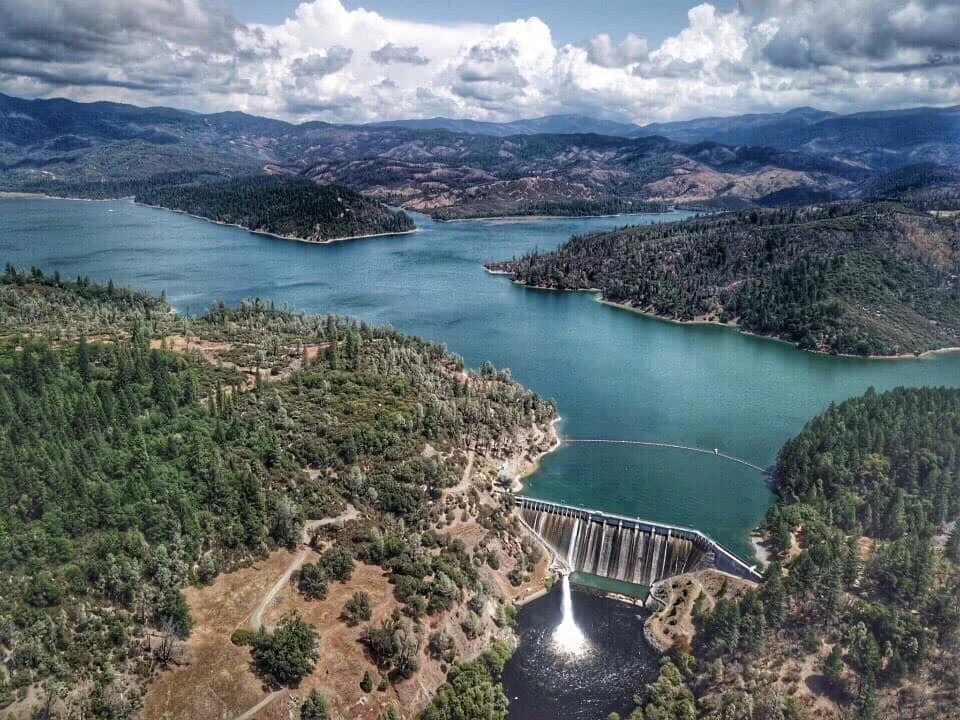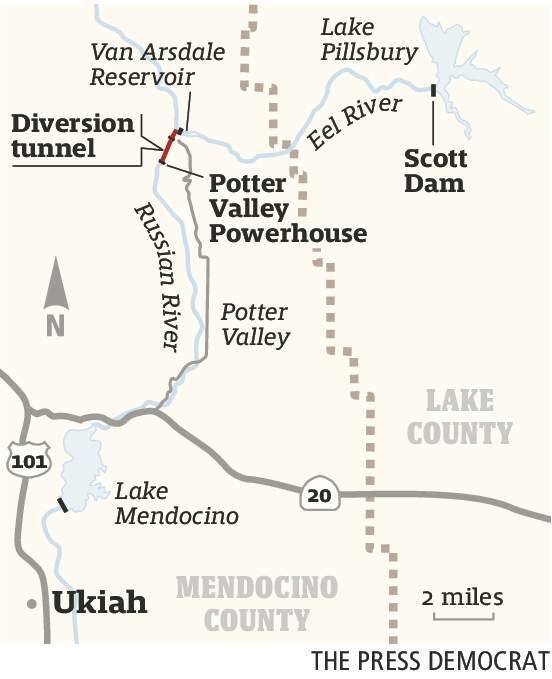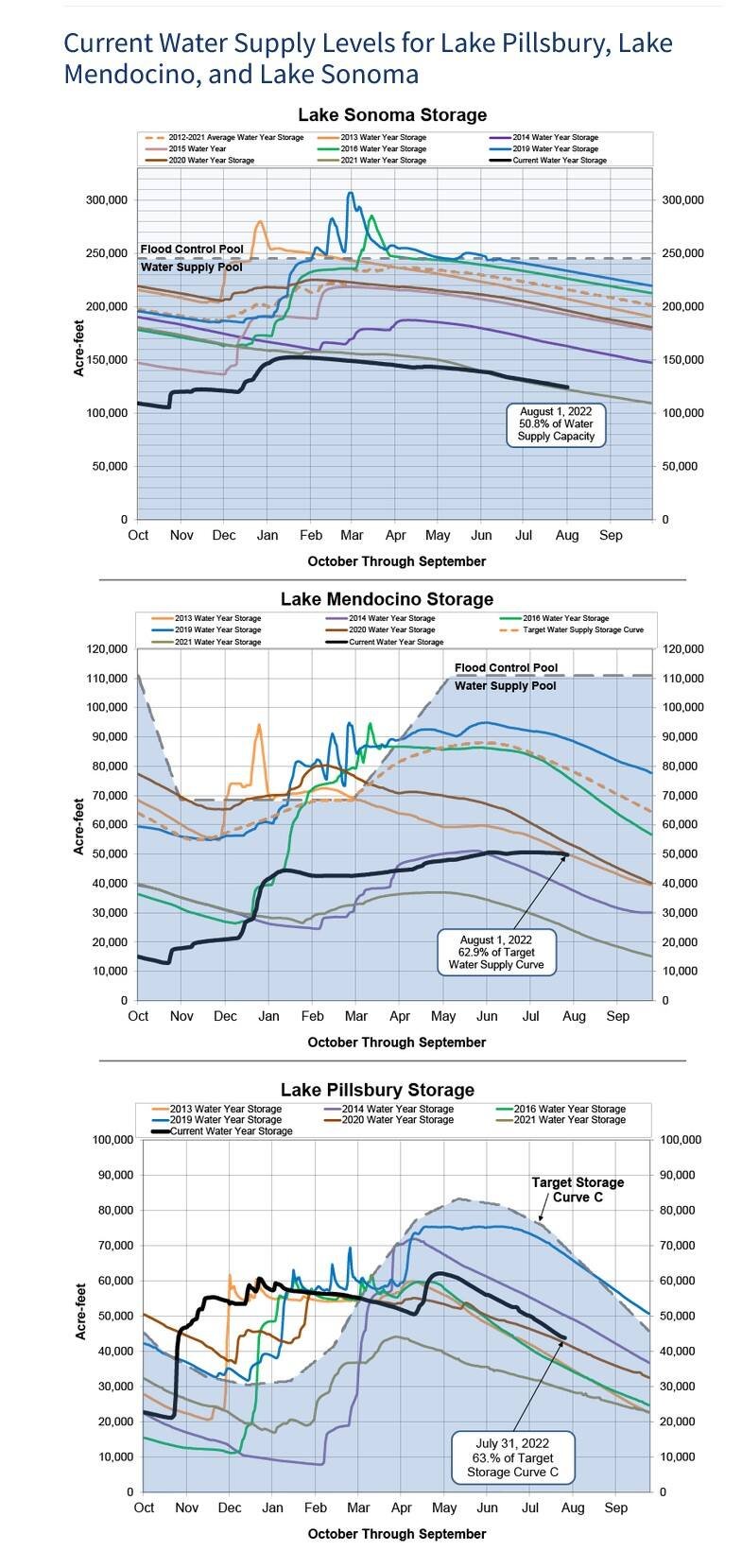MENDO FEVER - July 18, 2023 by Sarah Reith
Fly fishing on the Russian River south of Frog Woman Rock [Picture by Matt LaFever]
The Potter Valley Project has two deadlines for public comment coming up next month. One is a proposal for a flow variance, which takes into account recent developments with the embattled water diversion facility.
The other is garnering statewide interest in PG&E’s request to transfer its non-nuclear generating assets to a subsidiary called Pacific Generation. That includes all its hydropower projects, some of which, like the one in Potter Valley, are running under expired licenses and are slated for decommissioning. Potter Valley has not been able to generate electricity since December of 2021, due to a broken piece of equipment in the powerhouse.
Agencies and members of the public have until August fourth to comment on PG&E’s request to reduce flows into the East Fork of the Russian River from 75 cubic feet per second to 25, with flexibility to reduce the flows to 5 if water temperatures below Scott Dam exceed 60 degrees Fahrenheit or 16 degrees Celsius. This is a mitigation measure to protect salmon, which require cold water. PG&E says its request includes provisions for water temperature monitoring, which the National Marine Fisheries Service as well as the Round Valley Indian Tribes have requested.
Five cfs is what the Russian River has gotten in severe drought years. But PG&E is reducing the storage capacity of Lake Pillsbury, in response to a recent revelation that Scott Dam is more susceptible to seismic risk than was previously known. To that end, the spillway gates on top of the dam remain open, though typically they would have been closed in April. Water is only being released through the needle valve at the bottom of the dam.
According to Sonoma Water, Lake Pillsbury currently holds 51,965 acre-feet, which is a little higher than it was this time last year, in spite of a dramatically wet winter.
Water is released from the reservoir for three different uses: The East Fork, which serves fisheries and human water users in the Russian River watershed; the Potter Valley Irrigation District, which has a contract with PG&E for up to 50 cfs; and the fisheries in the Eel River. The current request does not address the amount of water that would be released for the Potter Valley Irrigation District. According to Janet Pauli, a longtime Potter Valley advocate, the district is currently using about 20 cfs on an on-demand basis, though its contract has not been curtailed.
PG&E has requested flow variances every year since 2006, when its license was finalized with custom mitigation measures designed by regulatory agencies. Its most recent request states that it is developing a proposal for a long-term flow regime that will comply with environmental requirements in both watersheds as the spillway gates remain open.
PG&E has stated publicly that it intends to remove both Scott Dam and Cape Horn Dam, unless it can find a buyer that can operate the project. Sonoma Water Agency, which gets the lion’s share of water from Lake Mendocino, is trying to figure out how to continue the diversion without the dams. Removal of the two dams is estimated to cost between $118-236 million. The cost would be borne by ratepayers.
But the project could be in place for years. The license for the Kilarc-Cow Creek hydro project in Shasta County expired in 2007. PG&E filed an application to surrender the license in 2009. That project consists of two powerhouses, three dams, and an assortment of penstocks and spillways in two watersheds, each about 80 square miles. Now, ranchers and irrigators, who have water rights tied up in the project, have filed a motion to intervene in PG&E’s request to transfer the expired license to a newly-formed subsidiary. According to an article in an industry publication last year, “PG&E seeks to transfer its non-nuclear generation assets into the subsidiary company and then sell a minority stake in Pacific Generation.” The company believes that “would provide an efficient source of equity financing to help PG&E fund wildfire risk mitigation and clean energy investments.” PG&E would maintain majority ownership and its employees would continue to operate its assets.
But the Cow Creek water users told the Federal Energy Regulatory Commission that “the Commission should not approve transfer of the now-long expired license unless and until Pacific Generation has demonstrated its capacity to safety and effectively accomplish license surrender and project decommissioning, without adverse impacts on landowner interests or the environment. In deciding whether to approve the transfer, the Commission should also consider whether the proposed transfer of the license would further delay or otherwise interfere with the license surrender and project decommissioning.”
The California Hydropower Reform Coalition also weighed in, noting that the proposed transfer would be “the single largest transfer of FERC-issued licenses in California history.” Eight of the 22 projects are undergoing relicensing, and three are in the process of surrendering their licenses. The Coalition requested and was granted a thirty-day extension of the public comment period.
The Coalition’s 87-page filing includes testimony by Chris Shutes, Executive Director of the California Sportfishing Protection Alliance, a member organization. He doesn’t think PG&E has done a good job taking care of its assets, and argued that allowing it to transfer the licenses would give it further excuse to slow-walk long-deferred maintenance and decommissioning on a number of projects.
He listed PG&E’s bankruptcies, inadequate insurance, and “patterns of delay, short-term fixes over long-term reliability, and inadequate consideration of public safety” as reasons to be leery of the utility’s assurances.
His supporting examples included PG&E’s costly forty-year delay in rebuilding or decommissioning a powerhouse on the Feather River; a 24-year delay in restoring the Battle Creek Restoration Project; and Scott Dam’s seismic liabilities.
Earlier this year, the Division of Safety of Dams downgraded Scott Dam’s safety assessment from satisfactory to fair, based on the Gannett Fleming engineering firm’s findings of seismic deficiencies.
After establishing similarities among three small hydro projects that are deteriorating, costly to maintain, and, in the case of Scott Dam, potentially dangerous, Shutes urged the Commission not to transfer the Potter Valley Project’s license to Pacific Generation, writing that “the Potter Valley Project is itself a set of both short-term and long-term liabilities.”
The deadline to file comments about PG&E’s proposal to transfer the licenses to its subsidiary Pacific Generation is August 12th.
Instructions for commenting on proposals before FERC and signing up for notices:
Potter Valley Project docket No. 77-313
The Commission strongly encourages electronic filing. Please file comments, motions to intervene, and protests using the Commission’s eFiling system at http://www.ferc.gov/docs-filing/efiling.asp. Commenters can submit brief comments up to 6,000 characters, without prior registration, using the eComment system at http://www.ferc.gov/docs-filing/ecomment.asp. You must include your name and contact information at the end of your comments. For assistance, please contact FERC Online Support at FERCOnlineSupport@ferc.gov, (866) 208-3676 (toll free), or (202) 502-8659 (TTY). In lieu of electronic filing, you may submit a paper copy. Submissions sent via the U.S. Postal Service must be addressed to: Kimberly D. Bose, Secretary, Federal Energy Regulatory Commission, 888 First Street NE, Room 1A, Washington, DC 20426. Submissions sent via any other carrier must be addressed to: Kimberly D. Bose, Secretary, Federal Energy Regulatory Commission, 12225 Wilkins Avenue, Rockville, Maryland 20852. The first page of any filing should include the docket number P-77-313. Comments emailed to Commission staff are not considered part of the Commission record.
This filing may be viewed on the Commission's website at http://www.ferc.gov using the "eLibrary" link. Enter the docket number excluding the last three digits in the docket number field to access the document. You may also register online at http://www.ferc.gov/docs-filing/esubscription.asp to be notified via email of new filings and issuances related to this or other pending projects. For assistance, call 1-866-208-3676 or e-mail FERCOnlineSupport@ferc.gov, for TTY, call (202) 502-8659. Agencies may obtain copies of the application directly from the applicant.

![Fly fishing on the Russian River south of Frog Woman Rock [Picture by Matt LaFever]](https://images.squarespace-cdn.com/content/v1/5cc36435fd67935bb61a2214/309bd191-15c9-419c-a4aa-c6e947c330ea/6C2E5C0A-EC26-4408-9620-4964ECDFA31C_1_201_a.jpeg+copy.jpg)




